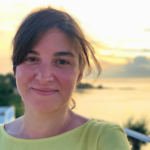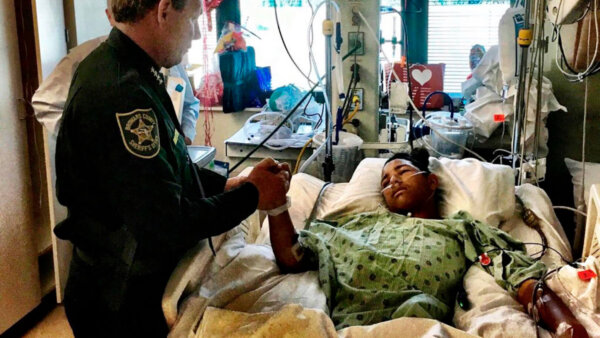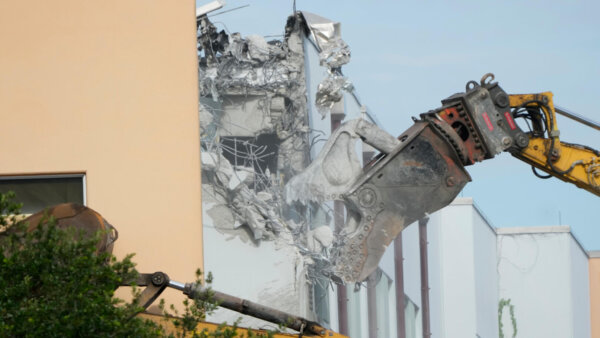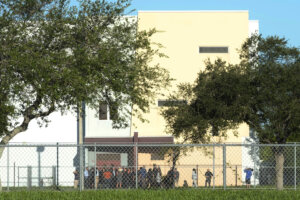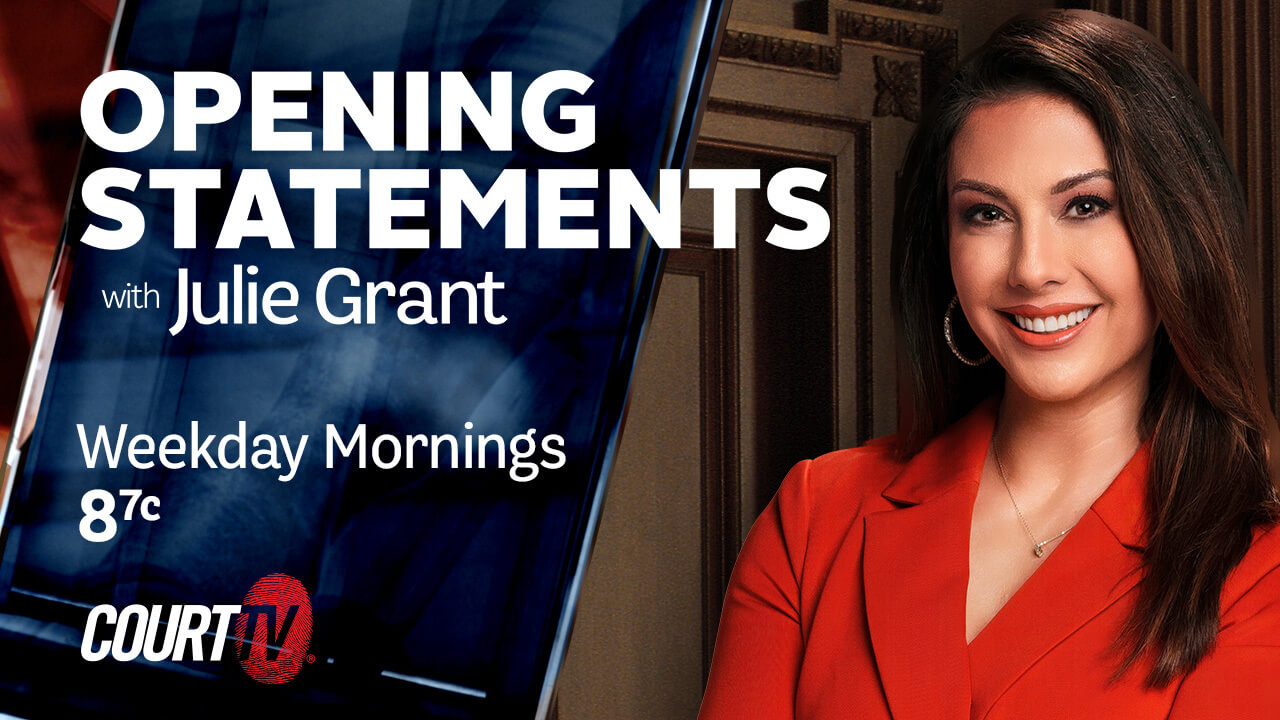FORT LAUDERDALE, Fla. (Court TV) — An extraordinary day in American journalism and jurisprudence began with a dice roll in the Fort Lauderdale, Florida, courthouse where the Parkland school shooter’s trial played out this summer.
The object for the participating journalists wasn’t a cash prize but an assignment unlike any other. They were vying for one of five spots on a media walkthrough of the site of the Feb. 14, 2018, massacre, which was preserved as a crime scene for more than four years in anticipation of this day.
The members of the media pool would tour the scene — after as the jury had — and record their impressions in a pool note to be shared with the rest of the media to use in their stories on the so-called “jury view.”
As one of the five journalists who participated, it’s easy for me to understand why prosecutors wanted the jury view and the gunman’s lawyers fought it at every turn. We were among the last people to bear witness to a crime scene that has cast a long and painful shadow over the Parkland community and beyond.
It still astounds me to think about what we observed and how we pulled it off. We came from different backgrounds and mediums, yet the key to our success came from the unique strengths we each brought to this solemn task.
Why we were there
Jury views of crime scenes are rare, partly because preserving a crime scene for extended periods is difficult. Then there’s the risk of arousing the jury’s passions, in the legal sense, moving them to make a decision based on emotions rather than the facts of the case.
Nevertheless, Broward County preserved the bloodstained halls and classrooms of Marjory Stoneman Douglas’ 1200 building for a jury to see in the gunman’s eventual trial.
Former MSD student Nikolas Cruz pleaded guilty in November 2021, paving the way for a penalty phase where a jury would decide if he deserved life in prison or death. Cruz’s lawyers tried to convince the judge overseeing the case that the jury deliberating his punishment didn’t need to see the crime scene. Cruz didn’t dispute what happened or how he carried out the shooting, they argued, and the jury had seen enough disturbing photos and videos to drive home the depravity of his actions.
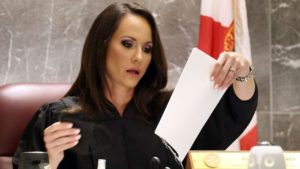
Judge Elizabeth Scherer looks at paperwork, at the Broward County Courthouse in Fort Lauderdale, Fla. on Wednesday, Oct. 20, 2021, during Marjory Stoneman Douglas High School shooter Nikolas Cruz’s guilty plea on all 17 counts of premeditated murder and 17 counts of attempted murder in the 2018 shootings.
Judge Elizabeth Scherer sided with the prosecution’s claim that seeing the crime scene would help the jury understand the evidence and Cruz’s role in context. And so, as the jurors gathered at the courthouse the morning of August 4 to board a bus to the high school, members of the press convened in a second-floor hallway and rolled a die for the chance to follow in their footsteps.
My network, Court TV, was granted a spot for national media because we contributed staff and gear to the pool camera rotation, so I sat out the dice roll. The Associated Press’ Terry Spencer and South Florida Sun-Sentinel reporter Rafael Olmedia were also guaranteed spots, leaving two spots for local television stations, which were won by WPLG’s Christina Vazquez and Joan Murray of WFOR.
It’s hard to overstate how coveted these spots were for the local journalists who lived and breathed this story for years. Most of them had a personal connection to the tragedy through a friend, a neighbor or a loved one. The media pool coordinator, veteran NBC 6 reporter Tony Pipitone, could have chosen a different way to choose pool members – or even claimed a spot for himself for having put in countless hours liaising between the court and the media. But a dice roll was the only fair way to do it, he said. After some tears and cheers, we had our pool.
Preparing ourselves
While the dice roll was underway, I was at my hotel a short cab ride away, anxiously awaiting a Doordash order I placed the night before for a clipboard and extra pens.
Earlier in the week, the media pool coordinator graciously shared with us floor plans he created of the hallways and classroom. Not only would they aid in note-taking, but we could use them as visuals in our reporting. The clipboard would help me as I zipped through the hallways jotting down observations, I told myself. I now see it as a creative attempt to feel in control while facing a situation for which I had no playbook.
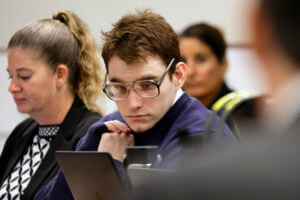
Marjory Stoneman Douglas High School shooter Nikolas Cruz is shown at the defense table during the penalty phase of Cruz’s trial at the Broward County Courthouse in Fort Lauderdale on Wednesday, Aug. 24, 2022. Cruz previously plead guilty to all 17 counts of premeditated murder and 17 counts of attempted murder in the 2018 shootings. (Amy Beth Bennett/South Florida Sun Sentinel via AP, Pool)
Those of us in the jury view pool knew what to expect in theory. All of us had participated in at some point the daily end-of-day viewing of surveillance videos, crime scene photos and autopsy pictures that were shown to the jury but restricted from the public eye. We were responsible for generating pool notes for those viewings as well. We fell into an effective routine of taking it all in and claiming portions to write up as we hurried out of the courtroom back to the media room.
The night before the jury view, I reviewed my notes on the gunman’s path, the condition of each classroom and who was found where, but I still felt unprepared. We didn’t know how much time we would have to roam the hallways and classrooms. We only knew that we could not bring in any form of electronics or recording devices, just pen and paper to document the grim scene. Given the unknowns, even more concerning to me was how we would consolidate our thoughts into a cogent document as quickly as possible after the walkthrough. The producer in me was freaking out.
My fellow pool reporters had their own ways of preparing.
“One of the first things I did, when it was clear that I would be participating in the walk-through, was to check my motives,” Rafael Olmeda later told me. “I had to make sure I wasn’t doing this out of morbid curiosity but out of a desire to make sure that the interests of journalism and justice were served. The state is trying to put someone to death and this is the evidence they’re using. It’s the same thing I did to prepare myself for viewing graphic photos, except on a larger scale.”
The AP’s Terry Spencer had quite the backstory when I asked him what he did to prepare:
“I began preparing for the trial and school visit in January. I realized late last year that between covering MSD, COVID, the Surfside condo collapse and some earlier work issues, I had allowed myself to get woefully out of shape – not good for a 62-year-old about to be covering the most mentally grueling story of his career. So on Jan. 1, I began a diet and fitness regimen that I have stuck to. I try to work out every day and watch what I eat and have mostly succeeded, losing 50 pounds and getting back to my college weight. This has also given me something personally positive to focus on during those days the trial gets particularly depressing – which was every day during the prosecution case.
“Then two days before the school visit, I got a text from my wife as we sat in the courtroom that she had tested positive for COVID. I was negative, but to stay that way I moved into a hotel until the visit was over. My assigned backup at AP has two young daughters just starting school and did not need to walk into that building.
“Going into it, I just tried to focus on the job at hand – like I do every day. There is a line in The Godfather II, ‘This is the business we’ve chosen,’ that I frequently quote and remember when doing particularly trying assignments. I am in this position because 40 years ago I chose to pursue a journalism career, a decision that has given me a life I couldn’t have imagined as a kid. My dad was a truck driver who had crappy knees and hips – if he could suck it up and do his job, so can I.
“I also gave myself a pep talk that morning that went something like this: There is no one in the world better prepared or more able to do this assignment. My 35 years in the business have given me skills I didn’t have when I started. I have been covering this tragedy since 10 minutes after it happened and built up a lot of knowledge. I owe it to myself, my mentors, my AP colleagues, the millions of AP readers, the other members of the pool and those others in the media room who will depend on our report to put those skills and knowledge to use and pull my weight. I especially owe it to the victim’s parents, spouses and families that, to the best of my ability, I bear true witness to what I see. And what we will see will be nothing compared to what the teachers, students and first responders saw and experienced.”
Court deputies lead jurors into the Stoneman Douglas “1200 building” on Aug. 4 to view the crime scene where 17 people were murdered in 2018. (Amy Beth Bennett/South Florida Sun Sentinel via AP)
The scene inside
I arrived at the courthouse a few minutes after the dice roll to meet the team. From there, we piled into a van with a Broward sheriff’s deputy at the wheel and joined the morning interstate rush on the way to the high school.
We made small talk about our experiences reporting on the shooting. We read aloud notes on the gunman’s path and compared them with our floor plans with the fervor of a crash college study session.

The 1200 building at Marjory Stoneman Douglas High School in Parkland, Fla., is pictured, on Wednesday, October 20, 2021. (Carline Jean/South Florida Sun-Sentinel via AP)
The streets of Parkland were closed to traffic as we got closer to the school. Deputies posted in front of squad cars waved us through the empty streets all the way to the school. The fenced-in 1200 building loomed large as we pulled into the west parking lot and waited for the jurors to show up. They arrived a few minutes later in two white vans accompanied by squad cars and other vehicles carrying the judge and the lawyers.
Per the agreement with the court, we would enter the building after the jury finished its visit. As we waited in our vehicle, my suggestion to assign people to certain rooms was voted down in favor of another plan: We would each take in as much as we could, then divide up the sections on the 30-minute drive back to the courthouse.
After nearly an hour inside, the jurors piled back into their vans and it was our turn. We were dropped off in front of the barricaded building where members of the prosecution team greeted us alongside sheriff’s deputies.
We were offered the same crime scene accessories as the jury, medical booties, gloves and masks. As some of us suited up, we were informed that we would only have 10 minutes to explore each floor. The prosecutors had to get back to the trial, after all. The producer in me was screaming inside.
We negotiated a workaround with the deputies: 10 minutes on the first floor, five minutes on the second floor – where no one was killed – 15 minutes on the third. We got to work by essentially leapfrogging over each other. If one of us was in a classroom, we went to the next one and did our best not to linger.
“I would walk into a classroom and hear their voices, the teachers and students who recounted for the jury what they saw and heard on that tragic day,” Christina Vazquez told me.
“Knowing I would not have enough time to handwrite all that I was observing, I made a conscious effort to first scan the room, and then zero in on details, taking visual screenshots if you will, to write from memory into the media pool report after the visit.”
Spencer used the deadline to his advantage.
“It was, see something, write it down, move along. See something, write it down, move along. And if I let my emotions get the best of me, that would have hurt my ability to accurately report what I saw. There were a few times that was tested. Looking at the alcoves where Gina Montalto, Luke Hoyer, Martin Duque Chris Hixon and Joaquin Oliver died, knowing they saw Cruz fire the fatal shots at them – that was hard. Also, looking at the unfinished chess game Peter Wang had been playing when the third floor was told to evacuate. The spot where he was shot and the spot where Jaime Guttenberg fell. But I had to keep going. It also helped that we were doing this as a team and, for me, writing is often therapy.”
I wasn’t about to let my clipboard or floorplans go to waste. I scribbled partial quotes from signs and posters hanging on the walls and what can best be described as pictograms of the remnants of the Valentine’s Day massacre – dusty gift bags, cards, candy boxes resting atop bullet-riddled desks.
Documenting what we saw
By the time we left, the jury had returned to the courthouse and the trial had resumed. People were waiting on us.
As we typed up our written notes on the ride back, we took stock of which areas each of us had the most details for and claimed them. When we returned to the courthouse, we began pouring our vignettes into the Google docs under section headers for each floor. When done, we all reviewed the completed draft and added missing details to other sections.
Two of us took a final pass over the whole document to copy edit, cut redundancies and add more classroom headers. This was a pool note intended to describe what others could not see, not a robust narrative. By 2 p.m., 90 minutes after we left the building, we hit send on our 2,148-word pool note. Then we got back to work.
After the state rested its case in chief that afternoon, each of us appeared on different networks to describe what we saw. I struggled to find the words to answer the first questions I would have asked someone in my position: What was it like? What will you remember most?
Surreal is the best single word I can come up with for what it was like. What has stuck in my mind’s eye is the sensation of shattered glass crunching underfoot, wedging into the soles of my shoes because I refused the booties.
What I’ll remember most is the professionalism, support and grace under pressure shown by my fellow pool reporters, who I now consider friends as well as colleagues.
I consider my work on the jury view one of my greatest public services as a journalist, but I question the necessity of it for all involved – the jurors, the journalists and the school community that has had to live in the building’s shadow all this time. Was it worth the lasting memories and trauma? Judging from the jury’s verdict of a life sentence for the gunman, I’m not so sure.
Emanuella Grinberg is a Court TV field producer with more than a decade of experience covering high-profile trials. She is an award-winning multi-platform journalist whose work has appeared on CNN, Smithsonian.com, Atlas Obscura and Poynter.






